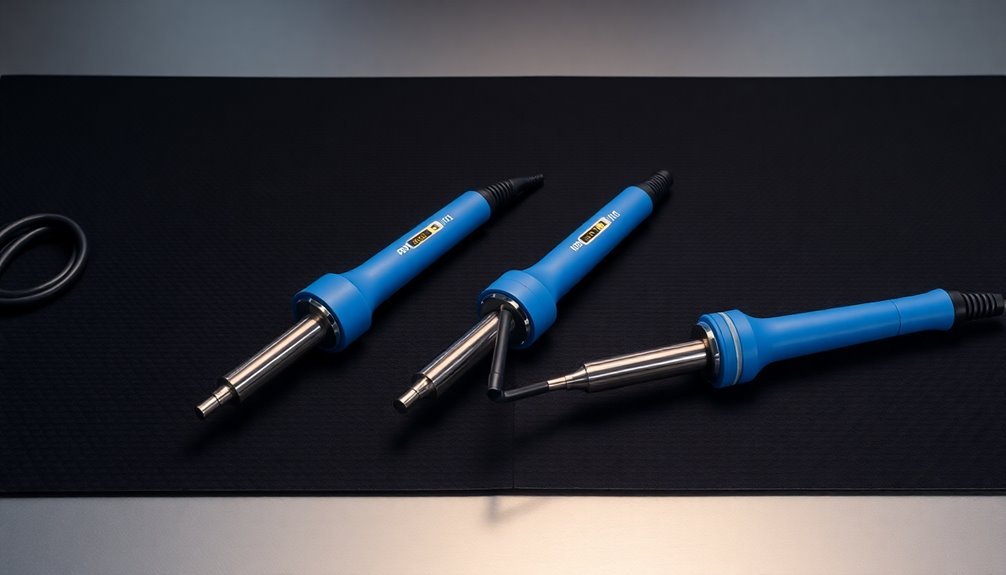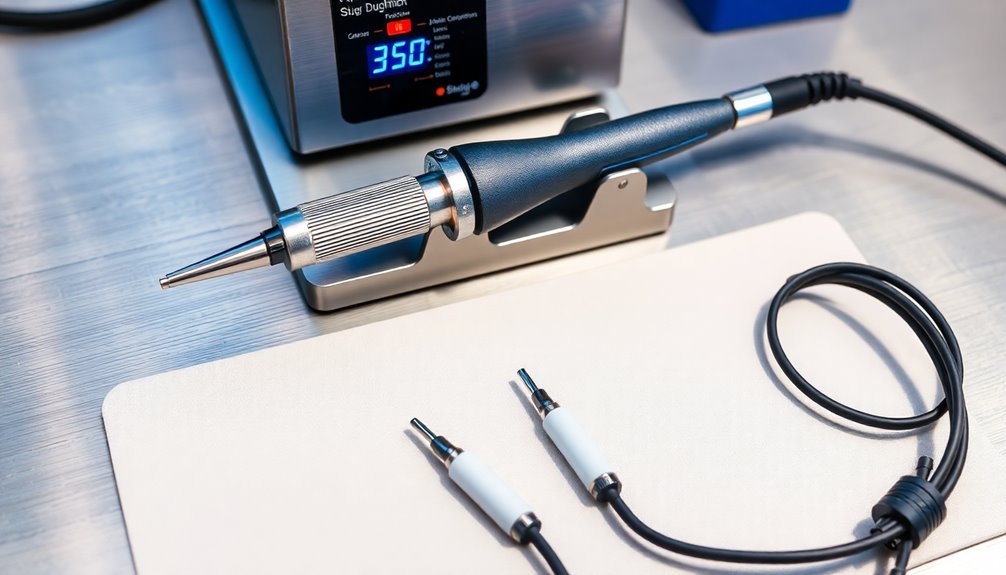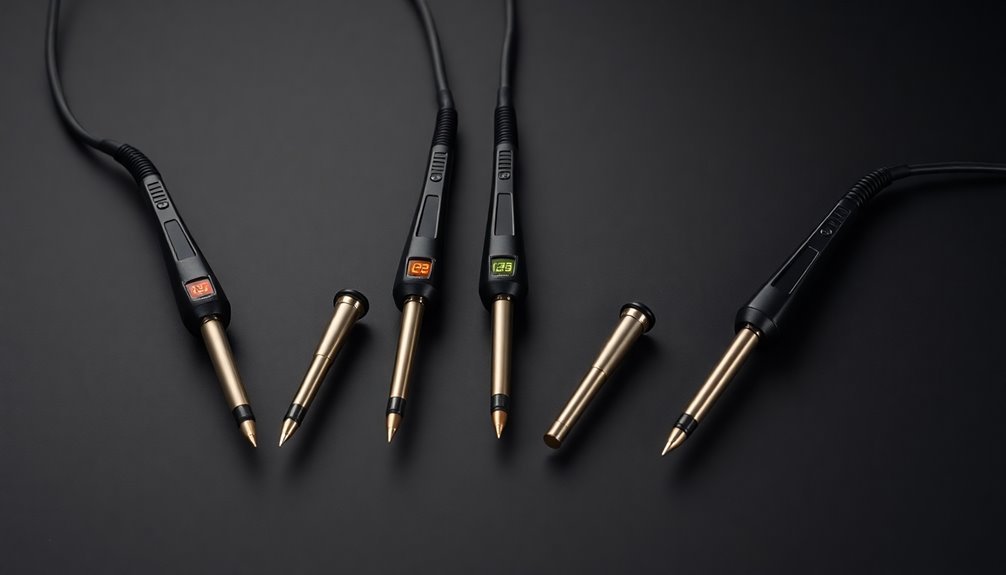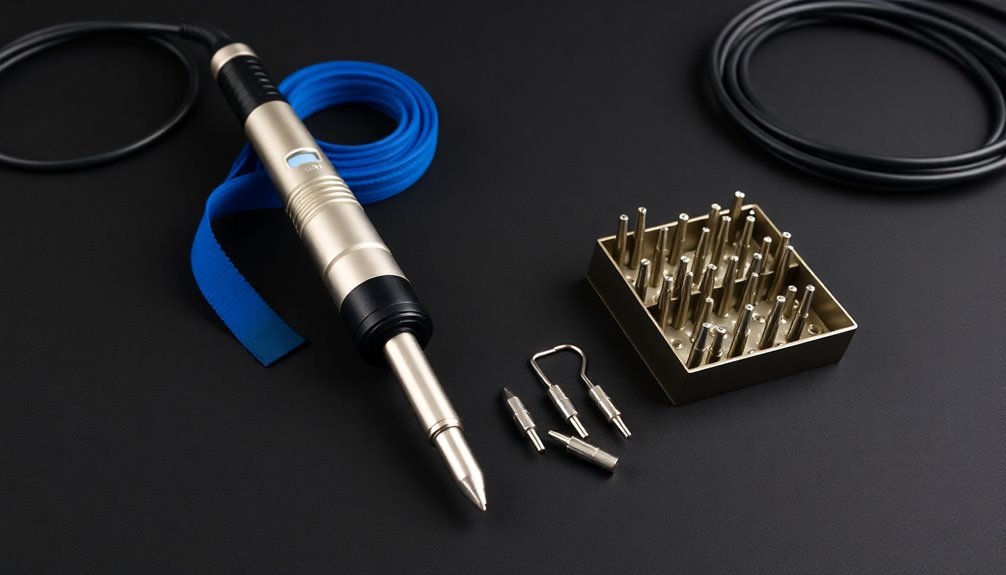When you need reliable static-safe soldering equipment, you'll find excellent options in the X-Tronic Model 3060-PRO and Hakko stations, both offering superior temperature control and ESD protection. The Aven 405 Series provides precision through its LCD display, while the Quakko 936 includes 10 versatile tips. For portability, consider the Pinecil or TS100 with their USB-C compatibility and smart power management. Each station features essential anti-static design, proper grounding mechanisms, and safety features like auto-shutoff. Whether you're a professional or hobbyist, these top picks deliver professional results while protecting your sensitive components from damaging static discharge. Let's explore their unique features and capabilities in detail.
Understanding Static-Safe Soldering Equipment

While working with sensitive electronic components, you'll need static-safe soldering equipment to prevent damage from electrostatic discharge (ESD).
A quality static-safe soldering station combines vital safety features like zero-voltage switching and anti-static design with proper grounding mechanisms to protect your components.
Your soldering station should include a control box, soldering iron, and iron holder, all manufactured with ESD-safe materials to prevent static buildup. Flux-core solder eliminates the need for separate flux application during soldering tasks.
Look for stations featuring precise temperature control with mechanical locks to maintain consistent heat levels during your work. The tip leakage voltage shouldn't exceed 0.5 mV to safeguard component safety.
You'll benefit from replaceable tips that offer versatility for different soldering tasks.
When using your equipment, it's essential to handle the iron properly and use appropriate flux-core solder or additional flux as needed.
Maintain your station regularly by cleaning it and verifying that all grounding connections remain secure.
Top Rated ESD Protected Irons
Several top-rated ESD protected irons stand out in today's market, offering reliable protection for sensitive electronic components. These models should ideally have resistance around 1 MOhm between the tip and ground for optimal ESD protection.
The X-Tronic Model 8010-XTS features dual independently controlled irons, while the Aven 405 Series provides precise temperature control through its LCD display. For professional-grade quality, you'll find Hakko stations delivering exceptional thermal mass and user-friendly operation.
If you're looking for portable options, consider the TS100 and TS101 smart soldering irons. They offer precise temperature control and can be powered via DC or USB. The Pinecil is another space-efficient choice, featuring USB-C compatibility and user-replaceable tips.
These top-rated models incorporate essential ESD protection features like direct grounding through 4mm banana plugs and anti-static construction. You'll find PID technology for temperature stability, and many include the recommended 1M ohm resistance in their grounding paths.
While CE certification doesn't guarantee ESD protection, look for specific ESD-safe labeling and compliance with US MIL standards. Whether you choose a smart soldering iron, complete station, or dual iron system, these options provide the static protection you need for sensitive electronic work.
Essential Safety Features

Building upon these quality ESD-protected models, proper safety features help prevent accidents and protect both users and components during soldering work.
You'll want to prioritize irons with touch-safe indicator LEDs that clearly show when the iron's temperature drops below 40°C, making it safe to handle. Look for models featuring free-fall detection and automatic shut-off mechanisms that activate during accidents or periods of inactivity. Advanced models like the FixHub Smart Soldering Iron include LED status rings that display different colors to indicate various operating states.
Essential physical safety features include sturdy stands and holders to secure your iron when not in use, along with well-insulated handles and grounded power cords.
You should also confirm that your chosen model has proper ESD protection to safeguard sensitive electronic components from static discharge.
For operational safety, select irons with idle mode functionality that reduces temperature when the tool isn't actively being used. This feature not only prevents accidents but also extends tip life.
Additionally, check that your soldering station includes proper grounding capabilities and meets relevant safety certifications like CE or UL standards.
Don't forget to verify that the iron has clear temperature indicators and controls that are easy to read and adjust while working.
Temperature Control Comparison
Through careful testing and comparison, temperature-controlled soldering stations consistently outperform basic soldering irons in both efficiency and precision.
You'll find that stations offer superior thermal efficiency of up to 80%, compared to basic irons at just 50%. They'll reach your target temperature faster, hitting 300°C in under 13 seconds, and maintain it more accurately through true thermostat control rather than simple power adjustment. Operating at a reduced 24V AC voltage, these stations provide enhanced safety compared to traditional 220V soldering irons.
When you're working with different types of solder and sensitive components, you'll want precise control within the 200°C to 480°C range. Temperature-controlled stations deliver this accuracy while protecting your components and extending tip life through smart power management that stops heating once the set temperature is reached.
- You can quickly adjust settings for lead-free solder, which requires higher temperatures
- Your tip temperature remains stable with rapid recovery times between joints
- You're able to calibrate the system to verify accurate readings, especially vital for professional work
The external control units in soldering stations provide better thermal balance, making them ideal for both routine electronics work and precision repairs of integrated circuits.
Price Performance Analysis

Smart soldering irons have revolutionized the market with impressive performance-to-price ratios. When you're looking for the best value, the Pinecil V2 stands out at around $30, offering rapid heating times and compatibility with TS-100 tips. The TS100 runs on a flexible power range from 12V to 24V DC, making it highly versatile.
You'll get professional-grade features without breaking the bank.
The TS100, priced at about $60, delivers exceptional performance with its sub-10-second heating capability and ability to handle up to 8 gauge wire. It's particularly suited for RC enthusiasts and automotive work.
While the TS80 costs slightly more at $80, both models provide smart features that were previously only available in premium stations.
If you're a professional requiring ultimate precision and reliability, Hakko stations ($100-$200) justify their higher price tag with advanced temperature control and extensive tip options. However, you'll find that budget-conscious options like the Pinecil V2 and TS100 now offer comparable performance features that were once exclusive to premium models.
For beginners, the Pinecil V2 represents the sweet spot of affordability and capability, while professionals might benefit from investing in a Hakko station for its durability and precision in demanding applications.
Frequently Asked Questions
How Often Should I Replace the Soldering Iron Tip?
You'll need to replace your soldering iron tip when you notice signs of corrosion, oxidation, or poor heat transfer. With proper maintenance and regular tinning, tips can last several months of regular use.
Can I Use Lead-Free Solder With Any Static-Safe Soldering Iron?
While you can use lead-free solder with most soldering irons, you'll need higher temperatures and proper temperature control. It's best to choose irons specifically designed for lead-free solder to prevent rapid tip wear.
What's the Average Lifespan of a Quality Static-Safe Soldering Iron?
You'll get 10+ years from a quality static-safe soldering iron with proper maintenance. However, if you're using it heavily (8+ hours daily), expect 2-3 years before needing significant repairs or replacement.
Is It Necessary to Tin the Tip Between Different Soldering Sessions?
Yes, you'll need to tin your soldering iron tip between sessions. It prevents oxidation, maintains heat transfer efficiency, and extends tip life. You should tin before, during, and after each use.
How Long Should I Let the Iron Cool Before Storing It?
You should let your soldering iron cool for at least 10-15 minutes before storing it. Keep it in its stand until it reaches room temperature to prevent accidents and damage to storage containers.
In Summary
When you're investing in static-safe soldering equipment, don't compromise on quality. You'll find that any of these seven ESD-protected irons will serve you well, but remember to match your choice with your specific needs and budget. Consider temperature control capabilities and safety features as your top priorities. Whether you're a hobbyist or professional, these tools will protect your sensitive electronics while delivering reliable performance.





Leave a Reply